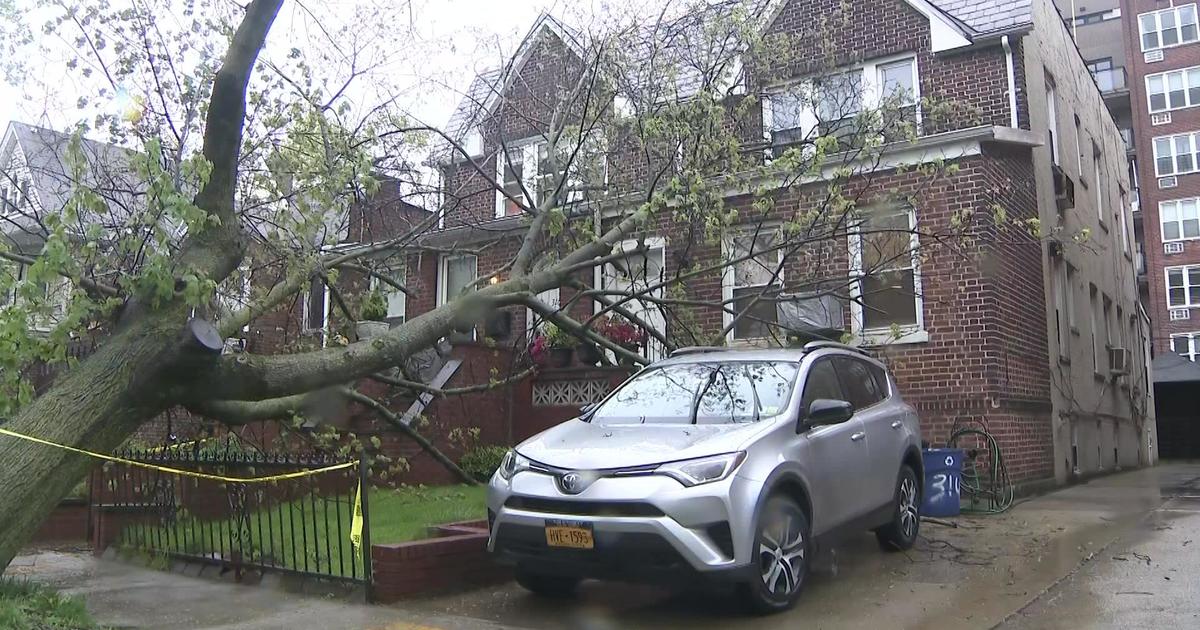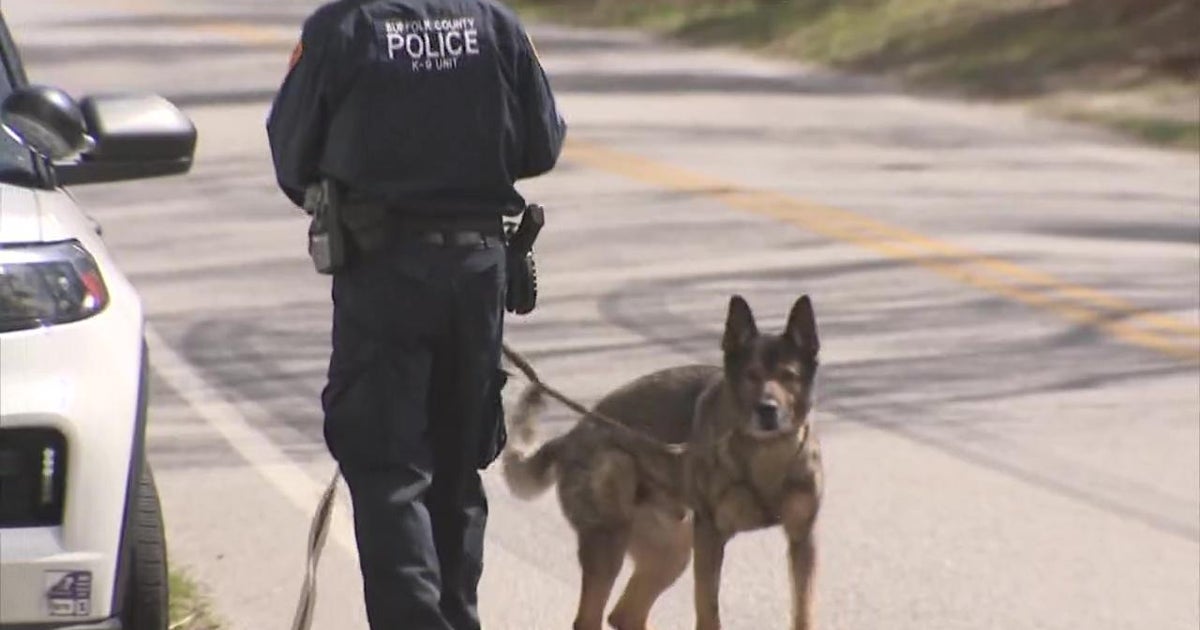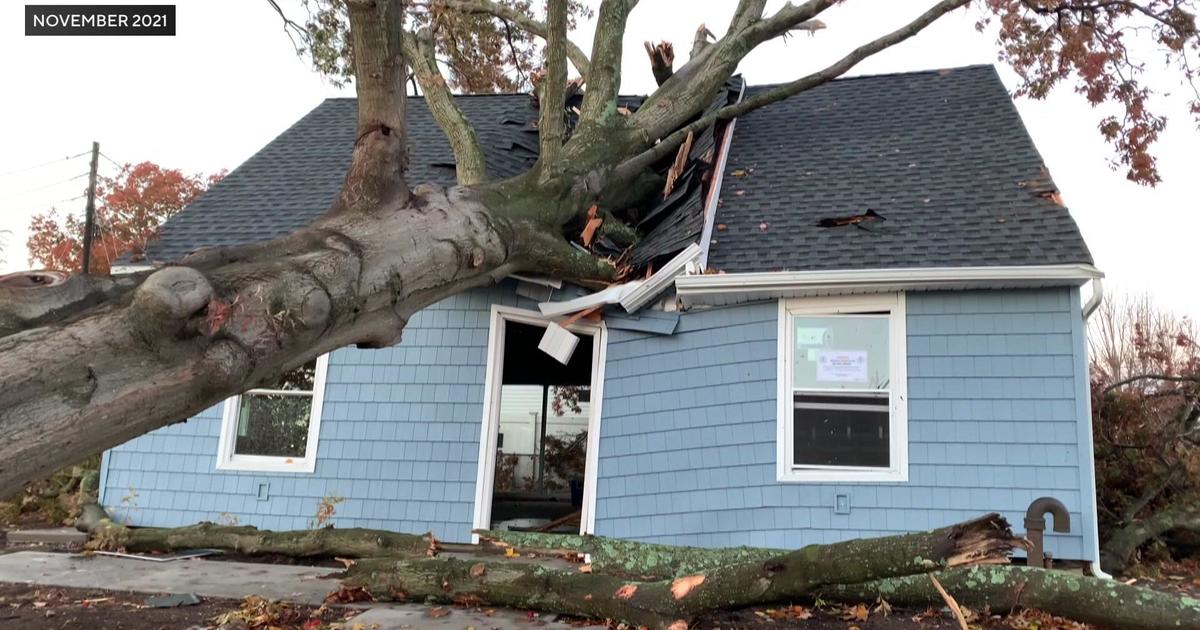Hurricane Irma Pounds Florida With Winds Over 100 MPH; Leaves Flooding, Power Outages, Severe Damage
MIAMI (CBSNewYork/AP) — Hurricane Irma pounded Florida throughout the afternoon and evening Sunday, bringing winds exceeding 105 mph.
CBS2's Lonnie Quinn reported as of 9 p.m., winds speeds were at 105 mph with gusts of 130 mph. Irma was headed north at 14 mph, and was 35 miles east-northeast of Fort Myers.
Some parts of the state, such as the Tampa Bay area, were still awaiting the worst Sunday night.
At 3:35 p.m., Irma made second landfall at Marco Island, 20 miles south-southeast of Naples, as a Category 3 storm. The wind speed at Marco Island was 115 mph, with gusts of 160 mph.
At Naples Municipal Airport, the wind speed measured 83 mph, with gusts of 115 mph at the time.
The storm had been over land ever since 9 p.m., and was expected to remain inland as it pushed toward Tampa.
The National Hurricane Center said Irma weakened to a Category 2 storm late Sunday, CBS affiliate WTSP-TV/Tampa Bay-Sarasota reported.
Dangerous storm surges were still expected in areas of onshore winds along the Florida West Coast late Sunday. Meanwhile, streets emptied across the bottom half of the Florida peninsula, and some 127,000 people huddled in shelters.
Earlier, Irma made another landfall and roared through the Florida Keys. As CBS2's Brian Conybeare reported, Irma earlier slammed into the Florida Keys. Upon making landfall there around 9 a.m. at Cudjoe Key in the Lower Florida Keys, the storm tossed sailboats like toys, flooded streets, and suddenly submerged trees on once-dry land.
An estimated 2.4 million customers were without power in Florida late Sunday and the number was growing, and collapsing a pair of construction cranes over the Miami skyline.
"I heard a loud crack and then a boom that followed that, and I assumed it something large fell, and I looked out the window and saw some of the remnants of the crane falling down on the building," said Gordon Apé.
Later, busy downtown Miami streets such as Brickell Avenue were turned into rivers. Parts of Biscayne Boulevard also had waves covering the concrete instead of cars.
"That right there is Biscayne Bay and all of that water is covering my block," one resident said
Because of all the damage, Miami-Dade County Mayor Carlos A. Giménez told those who did not leave that first responders could not perform rescues, and ordered a mandatory curfew of 7 p.m. Sunday to 7 a.m. Monday.
"This will allow our crews to start cleanup and clear roadways," he said. "We don't want extra people on the roadways while we're doing that."
Elsewhere the East Coast of Florida, a major concern late Sunday was tornadoes spurred by the hurricane. One was spotted in Fort Lauderdale, while another caused damage in Palm Bay.
The powerful winds tore awnings off buildings in Fort Lauderdale, and toppled a tree in a backyard there with the homeowner watching helpless.
"Thank God that did not land on our house," the homeowner said.
Meanwhile on the West Coast of Florida, the water was sucked right out of Tampa Bay and Sarasota Bay in what amounted to a reverse storm surge before the hurricane arrived – prompting some people to go out on the seagrass that is usually submerged despite being advised not to, CBS News' Carter Evans reported.
CBS affiliate WTSP-TV, Tampa Bay-Sarasota reported the receded water left two manatees stranded in knee-deep mud.
Marcelo Clavijo wrote on Facebook that he was getting "stir crazy," so he went to checked out the bay near Whitfield -- he noticed the manatees on the flats.
Clavijo and a few residents came to the rescue and placed the manatees onto a large green tarp, where they were pulled more than 100 yards back into the water, WTSP reported.
Nearby, trees were down over the bridge to Bay Island and Siesta Key, which was evacuated Saturday night.
Alex Marquardt of CNN reported for WFOR-TV, CBS4 Miami that weather conditions deteriorated significantly in Sarasota late Sunday evening, with the tops of palm trees getting tossed around like rag dolls and rain coming down like thumbtacks. Officials said any possible power outages there could last for weeks.
As night fell just to the north in Tampa, Irma's strong winds and heavy rains started to bear down. The city was also bracing for the storm surge that is likely to inundate the area, CBS News' Don Champion reported.
"It's been the most sickening, gut-wrenching feeling just waiting for this storm to hit," said Tampa evacuee Lauren Holsen.
Holsen was ordered to evacuate from Tampa and is now in Georgia. She could not believe the eerie scenes of Tampa Bay with the water sucked out and dogs romping around on where several feet of water would normally be.
"I'm terrified for the people that stuck around," Holsen said.
The Tampa-St. Petersburg area has not been struck by a major hurricane since 1921, when its population was about 10,000, National Hurricane Center spokesman Dennis Feltgen said. Now, around 3 million people live there.
Back down in the Florida Keys, storm surge was wrapping over Overseas Highway as of 6:30 p.m., CBS News reported. Monroe County, Florida officials said the effects of the storm amounted to a humanitarian disaster for the Florida Keys.
Irma struck as a Category 4 in the morningbut by midafternoon had weakened to a Category 3 with still-fearsome three-figure mph winds and heavy rain before finally dropping to a Category 2. A storm surge of more than 10 feet of water was recorded in part of the Keys, and similar flooding was expected on the mainland.
EXTRAS: Latest | Irma Tips & Info | CBS Miami | CBSN | Track | Photos | Videos
CBS News has confirmed three deaths in Florida since Irma arrived, though it is not clear whether the deaths are a direct result of Irma.
In Hardee County, two law enforcement officers – Deputy Sheriff Julie Bridges, 42, of Zolfo Springs and an unidentified employee of the Florida Department of Corrections – were killed while driving home from a shelter.
A man also died in Monroe County when his vehicle hit a tree, CBS News reported.
Many streets were underwater in downtown Miami and other cities. Appliances and furniture were seen floating away in the low-lying Keys, though the full extent of Irma's wrath there was not clear.
A Miami woman who went into labor was guided through delivery by phone when authorities couldn't reach her in high winds and street flooding. Firefighters later took her to the hospital.
Irma also spawned at least three possible tornadoes.
An apparent tornado spun off by Irma destroyed six mobile homes in Palm Bay, hundreds of miles away along the state's Atlantic coast. Flooding was reported along Interstate 4, which cuts across Florida's midsection.
CBS Affiliate WTSP-TV/Tampa Bay-Sarasota | CBS Affiliate WINK-TV/Fort Myers
Florida Power & Light Company said that nearly 1.5 million customers statewide were without power throughout the state as of Sunday afternoon.
"I'm scared to death," said 60-year-old Carol Walterson Stroud, who sought refuge in a senior center in Florida's southernmost city with her husband, granddaughter and dog. The streets emptied and shops were boarded up before the wind started to howl.
Early Sunday evening, President Donald Trump approved a major disaster declaration for nine Florida counties Sunday afternoon, as Hurricane Irma pounded the state.
The declaration makes federal funding available to those affected in counties in both east and west coastal Florida and the Keys – including Charlotte, Collier, Hillsborough, Lee, Manatee, Miami-Dade, Monroe, Pinellas, and Sarasota.
"We are concerned about lives, not cost," Trump said.
Assistance can include such things as grants for temporary housing and home repairs, low-cost loans for uninsured property losses, and other programs to help individuals and business owners.
Federal funding is also available to the state and to tribal and eligible local governments, as well as some private nonprofits on a cost-sharing basis, for emergency work in all 67 Florida counties.
"As Hurricane Irma makes landfall in Florida, we are fully committed to providing every resource to Floridians for response and recovery. We will spare no expense to save lives and help Floridians. We've worked aggressively all week to prepare for this powerful storm and keep people safe, but we have a long road ahead," Gov. Scott was quoted by WTSP.
Before the hurricane arrived, Scott had warned residents in the state's evacuation zones Saturday that "this is your last chance to make a good decision." About 6.4 million people were told to flee.
More than 10,000 National Guard members are going to be coming to the state, CBS News reported. Scott has already called up 7,000 members of the Florida National Guard to help with recovery efforts.
There have been some reports of isolated looting in Miami and Fort Lauderdale. Six people had been arrested as of Sunday night.
Earlier, at least 25 people in one Florida county were arrested for violating a curfew imposed as Irma approached the state.
Irma is forecast to stretch into the Florida Panhandle and then to Georgia, the Carolinas, Tennessee and Alabama. President Trump has already issued emergency declarations for some of those areas.
Irma was at one time the most powerful hurricane ever recorded in the open Atlantic with a peak wind speed of 185 mph last week. It left more than 20 people dead across the Caribbean.
(© Copyright 2017 CBS Broadcasting Inc. All Rights Reserved. The Associated Press contributed to this report.)



